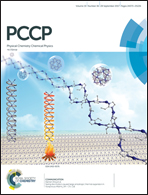The electronic properties of three popular high spin complexes [TM(acac)3, TM = Cr, Mn, and Fe] revisited: an experimental and theoretical study†
Abstract
The occupied and unoccupied electronic structures of three high spin TM(acac)3 (TM = Cr, Mn, and Fe) complexes (I, II, and III, respectively) were studied by revisiting their literature vapour-phase He(I) and, when available, He(II) photoemission (PE) spectra and by means of original near-edge X-ray absorption fine structure (NEXAFS) spectroscopic data recorded at the O K-edge (OK-edge) and TM L2,3-edges (TML2,3-edges). The assignments of the vapour-phase He(I)/He(II) PE spectra were guided by the results of spin-unrestricted non-relativistic Slater transition state calculations, while the OK-edge and TML2,3-edge spectroscopic pieces of evidence were analysed by exploiting the results of spin-unrestricted scalar-relativistic time-dependent density functional theory (DFT) and DFT/ROCIS calculations, respectively. Although the actual symmetry (D3, in the absence of any Jahn–Teller distortion) of the title molecules allowed an extensive mixing between TM t2g-like and eg-like atomic orbitals, the use of the Nalewajski–Mrozek TM–O bond multiplicity index combined with a thorough analysis of the ground state (GS) outcomes allowed the assessment of the TM–O bond weakening associated with the progressive TM 3d-based eg-like orbital filling. The experimental information provided by OK-edge spectra was rather poor; nevertheless, the combined use of symmetry, orbitals and spectra allowed us (i) to rationalise minor differences characterizing spectral features along the series, (ii) to quantify the contribution provided by the ligand-to-metal-charge-transfer (LMCT) excitations to the different spectral features, and (iii) to recognize the t2g-/eg-like nature of the TM 3d-based orbitals involved in LMCT transitions. As far as the TML2,3-edge spectra and the DFT/ROCIS results were concerned, the lowest lying I,IIL3 spectral features included states having either the GS spin multiplicity (S(I) = 3/2, S(II) = 2) or, at higher excitation energies (EEs), states with ΔS = ±1. In contrast to that, only states with ΔS = 0, −1 significantly contributed to the IIIL3 spectral pattern. Along the whole series, the L3 higher EE side was systematically characterized by states involving TM2p → π4 MLCT excitations; as such, coupled-single excitations with ΔS = 0 were involved in I and II, while single MLCT TM2p → π4 transitions with ΔS = −1 were involved in III.
![Graphical abstract: The electronic properties of three popular high spin complexes [TM(acac)3, TM = Cr, Mn, and Fe] revisited: an experimental and theoretical study](/en/Image/Get?imageInfo.ImageType=GA&imageInfo.ImageIdentifier.ManuscriptID=C7CP04461E&imageInfo.ImageIdentifier.Year=2017)


 Please wait while we load your content...
Please wait while we load your content...